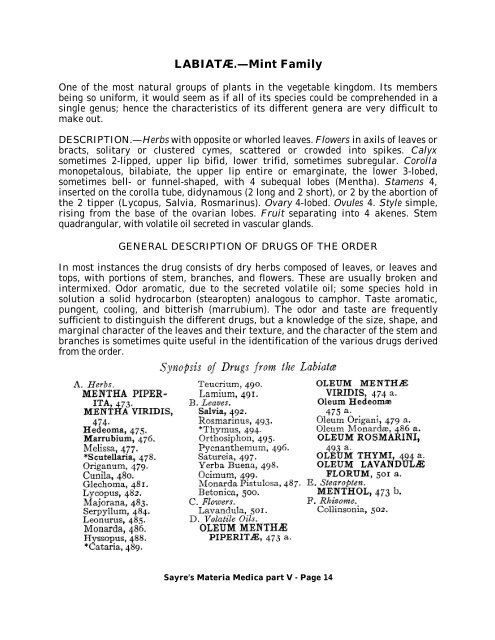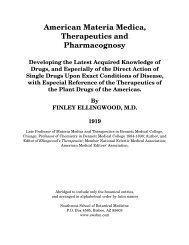SAYRE'S MATERIA MEDICA - Part V - Southwest School of ...
SAYRE'S MATERIA MEDICA - Part V - Southwest School of ...
SAYRE'S MATERIA MEDICA - Part V - Southwest School of ...
You also want an ePaper? Increase the reach of your titles
YUMPU automatically turns print PDFs into web optimized ePapers that Google loves.
LABIATÆ.—Mint Family<br />
One <strong>of</strong> the most natural groups <strong>of</strong> plants in the vegetable kingdom. Its members<br />
being so uniform, it would seem as if all <strong>of</strong> its species could be comprehended in a<br />
single genus; hence the characteristics <strong>of</strong> its different genera are very difficult to<br />
make out.<br />
DESCRIPTION.—Herbs with opposite or whorled leaves. Flowers in axils <strong>of</strong> leaves or<br />
bracts, solitary or clustered cymes, scattered or crowded into spikes. Calyx<br />
sometimes 2-lipped, upper lip bifid, lower trifid, sometimes subregular. Corolla<br />
monopetalous, bilabiate, the upper lip entire or emarginate, the lower 3-lobed,<br />
sometimes bell- or funnel-shaped, with 4 subequal lobes (Mentha). Stamens 4,<br />
inserted on the corolla tube, didynamous (2 long and 2 short), or 2 by the abortion <strong>of</strong><br />
the 2 tipper (Lycopus, Salvia, Rosmarinus). Ovary 4-lobed. Ovules 4. Style simple,<br />
rising from the base <strong>of</strong> the ovarian lobes. Fruit separating into 4 akenes. Stem<br />
quadrangular, with volatile oil secreted in vascular glands.<br />
GENERAL DESCRIPTION OF DRUGS OF THE ORDER<br />
In most instances the drug consists <strong>of</strong> dry herbs composed <strong>of</strong> leaves, or leaves and<br />
tops, with portions <strong>of</strong> stem, branches, and flowers. These are usually broken and<br />
intermixed. Odor aromatic, due to the secreted volatile oil; some species hold in<br />
solution a solid hydrocarbon (stearopten) analogous to camphor. Taste aromatic,<br />
pungent, cooling, and bitterish (marrubium). The odor and taste are frequently<br />
sufficient to distinguish the different drugs, but a knowledge <strong>of</strong> the size, shape, and<br />
marginal character <strong>of</strong> the leaves and their texture, and the character <strong>of</strong> the stem and<br />
branches is sometimes quite useful in the identification <strong>of</strong> the various drugs derived<br />
from the order.<br />
Sayre’s Materia Medica part V - Page 14
















